SQL case study: merging and splitting strings
This article brings you relevant knowledge about SQL server. It mainly introduces you to the relevant information about the merging and splitting of strings in SQL case study. The article introduces the two methods respectively. This method has certain reference learning value for everyone to learn or use Oracle. Friends in need can refer to it.

Recommended study: "SQL Tutorial"
Merge of strings
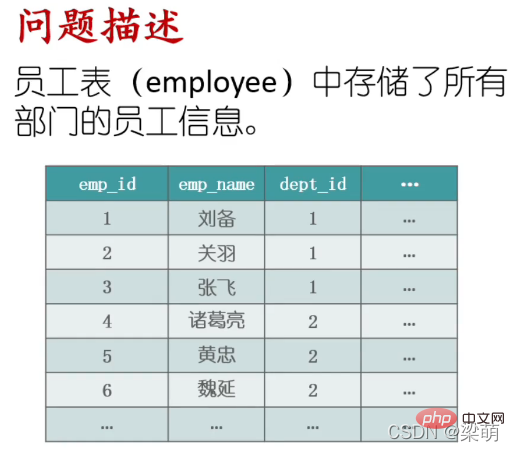
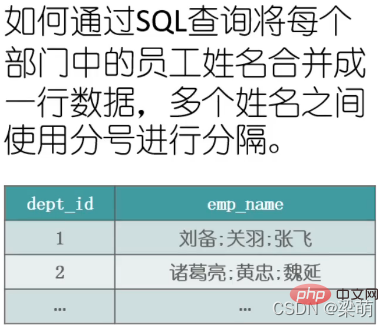
There may be multiple implementation methods in Oracle. Currently, there are two known to me. The implementation of these two types is recorded below:
String merging method One:
Implement SQL:
--方法一 SELECT d.dept_name,wm_concat(e.emp_name) FROM employee e INNER JOIN department d ON d.dept_id=e.dept_id GROUP BY d.dept_name;
Execution result:

SQL analysis:
Use Oracle's own wm_concat() function to merge strings. There is a disadvantage here. The merged connection symbol can only be the default comma, and other symbols cannot be used.
String merging method two:
Implement SQL:
--方法二 SELECT d.dept_name, LISTAGG (e.emp_name, ',') WITHIN GROUP (ORDER BY e.emp_name) names FROM employee e INNER JOIN department d ON d.dept_id=e.dept_id GROUP BY d.dept_name;
Execution result:

SQL analysis:
Use Oracle's own LISTAGG() function to merge strings. Its advantage is that the merged connection symbol can be specified as any characters, and can easily implement ORDER BY sorting.
String splitting
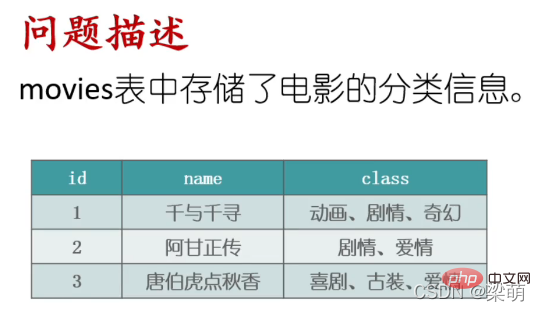
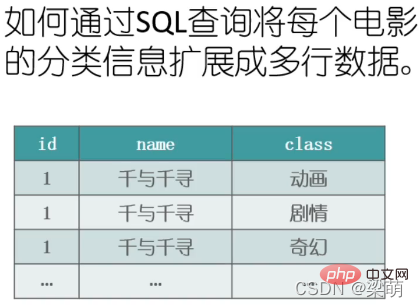
There may be multiple implementation methods in Oracle, the ones I know so far There are two types. The implementation of these two types is recorded below:
String splitting method one:
Implementation of SQL:
--方法一
WITH t (id, name, sub, str) AS (
SELECT id, name, substr(class, 1, instr(class, '、')-1), substr(concat(class,'、'), instr(class, '、')+1)
FROM movies
UNION ALL
SELECT id, name,substr(str, 1, instr(str, '、')-1), substr(str, instr(str, '、')+1)
FROM t WHERE instr(str, '、')>0
)
SELECT id, name, sub
FROM t
ORDER BY id;Execution result:
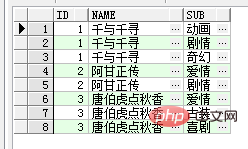
##SQL analysis:
This statement is a little complicated, and it will be explained step by step below:First look at the original data of the movies table: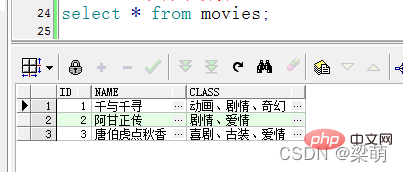
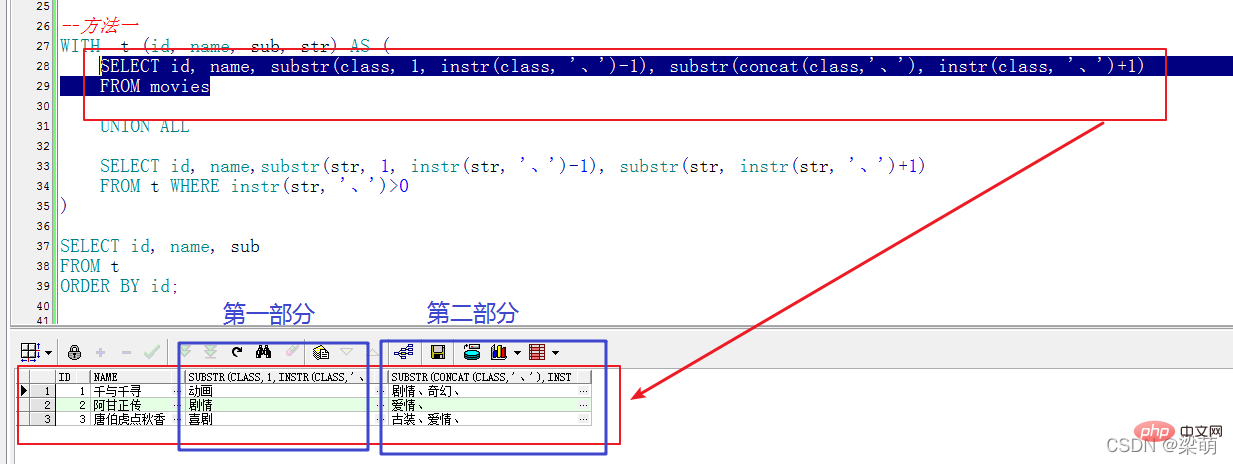


Implement SQL:
--方法二 SELECT m.name,t.column_value FROM movies m,TABLE(SPLIT(m.class,'、')) t;
Execution result:
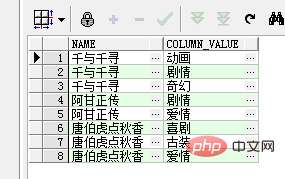
SQL analysis:
This method actually processes strings by customizing a function. , the logic of function split is actually similar to the logic of method 1. They both use recursion to split the values in the string one by one according to the delimiter, and finally return the split string. Personally, I feel this method is better because it encapsulates the splitting logic, making it simpler to use and clearer in logic. The following is the creation script of the split function:create or replace function split (p_list clob, p_sep varchar2 := ',')
return tabletype
pipelined
is
l_idx pls_integer;
v_list varchar2 (32676) := to_char(p_list);
begin
loop
l_idx := instr (v_list, p_sep);
if l_idx > 0
then
pipe row (substr (v_list, 1, l_idx - 1));
v_list := substr (v_list, l_idx + length (p_sep));
else
pipe row (v_list);
exit;
end if;
end loop;
end;create or replace type tabletype as table of varchar2(32676);
SQL Tutorial"
The above is the detailed content of SQL case study: merging and splitting strings. For more information, please follow other related articles on the PHP Chinese website!

Hot AI Tools

Undresser.AI Undress
AI-powered app for creating realistic nude photos

AI Clothes Remover
Online AI tool for removing clothes from photos.

Undress AI Tool
Undress images for free

Clothoff.io
AI clothes remover

Video Face Swap
Swap faces in any video effortlessly with our completely free AI face swap tool!

Hot Article

Hot Tools

Notepad++7.3.1
Easy-to-use and free code editor

SublimeText3 Chinese version
Chinese version, very easy to use

Zend Studio 13.0.1
Powerful PHP integrated development environment

Dreamweaver CS6
Visual web development tools

SublimeText3 Mac version
God-level code editing software (SublimeText3)

Hot Topics
 1669
1669
 14
14
 1428
1428
 52
52
 1329
1329
 25
25
 1273
1273
 29
29
 1256
1256
 24
24
 What is the difference between HQL and SQL in Hibernate framework?
Apr 17, 2024 pm 02:57 PM
What is the difference between HQL and SQL in Hibernate framework?
Apr 17, 2024 pm 02:57 PM
HQL and SQL are compared in the Hibernate framework: HQL (1. Object-oriented syntax, 2. Database-independent queries, 3. Type safety), while SQL directly operates the database (1. Database-independent standards, 2. Complex executable queries and data manipulation).
 Usage of division operation in Oracle SQL
Mar 10, 2024 pm 03:06 PM
Usage of division operation in Oracle SQL
Mar 10, 2024 pm 03:06 PM
"Usage of Division Operation in OracleSQL" In OracleSQL, division operation is one of the common mathematical operations. During data query and processing, division operations can help us calculate the ratio between fields or derive the logical relationship between specific values. This article will introduce the usage of division operation in OracleSQL and provide specific code examples. 1. Two ways of division operations in OracleSQL In OracleSQL, division operations can be performed in two different ways.
 Comparison and differences of SQL syntax between Oracle and DB2
Mar 11, 2024 pm 12:09 PM
Comparison and differences of SQL syntax between Oracle and DB2
Mar 11, 2024 pm 12:09 PM
Oracle and DB2 are two commonly used relational database management systems, each of which has its own unique SQL syntax and characteristics. This article will compare and differ between the SQL syntax of Oracle and DB2, and provide specific code examples. Database connection In Oracle, use the following statement to connect to the database: CONNECTusername/password@database. In DB2, the statement to connect to the database is as follows: CONNECTTOdataba
 Detailed explanation of the Set tag function in MyBatis dynamic SQL tags
Feb 26, 2024 pm 07:48 PM
Detailed explanation of the Set tag function in MyBatis dynamic SQL tags
Feb 26, 2024 pm 07:48 PM
Interpretation of MyBatis dynamic SQL tags: Detailed explanation of Set tag usage MyBatis is an excellent persistence layer framework. It provides a wealth of dynamic SQL tags and can flexibly construct database operation statements. Among them, the Set tag is used to generate the SET clause in the UPDATE statement, which is very commonly used in update operations. This article will explain in detail the usage of the Set tag in MyBatis and demonstrate its functionality through specific code examples. What is Set tag Set tag is used in MyBati
 What does the identity attribute in SQL mean?
Feb 19, 2024 am 11:24 AM
What does the identity attribute in SQL mean?
Feb 19, 2024 am 11:24 AM
What is Identity in SQL? Specific code examples are needed. In SQL, Identity is a special data type used to generate auto-incrementing numbers. It is often used to uniquely identify each row of data in a table. The Identity column is often used in conjunction with the primary key column to ensure that each record has a unique identifier. This article will detail how to use Identity and some practical code examples. The basic way to use Identity is to use Identit when creating a table.
 How to solve the 5120 error in SQL
Mar 06, 2024 pm 04:33 PM
How to solve the 5120 error in SQL
Mar 06, 2024 pm 04:33 PM
Solution: 1. Check whether the logged-in user has sufficient permissions to access or operate the database, and ensure that the user has the correct permissions; 2. Check whether the account of the SQL Server service has permission to access the specified file or folder, and ensure that the account Have sufficient permissions to read and write the file or folder; 3. Check whether the specified database file has been opened or locked by other processes, try to close or release the file, and rerun the query; 4. Try as administrator Run Management Studio as etc.
 How to use SQL statements for data aggregation and statistics in MySQL?
Dec 17, 2023 am 08:41 AM
How to use SQL statements for data aggregation and statistics in MySQL?
Dec 17, 2023 am 08:41 AM
How to use SQL statements for data aggregation and statistics in MySQL? Data aggregation and statistics are very important steps when performing data analysis and statistics. As a powerful relational database management system, MySQL provides a wealth of aggregation and statistical functions, which can easily perform data aggregation and statistical operations. This article will introduce the method of using SQL statements to perform data aggregation and statistics in MySQL, and provide specific code examples. 1. Use the COUNT function for counting. The COUNT function is the most commonly used
 Database technology competition: What are the differences between Oracle and SQL?
Mar 09, 2024 am 08:30 AM
Database technology competition: What are the differences between Oracle and SQL?
Mar 09, 2024 am 08:30 AM
Database technology competition: What are the differences between Oracle and SQL? In the database field, Oracle and SQL Server are two highly respected relational database management systems. Although they both belong to the category of relational databases, there are many differences between them. In this article, we will delve into the differences between Oracle and SQL Server, as well as their features and advantages in practical applications. First of all, there are differences in syntax between Oracle and SQL Server.




